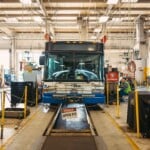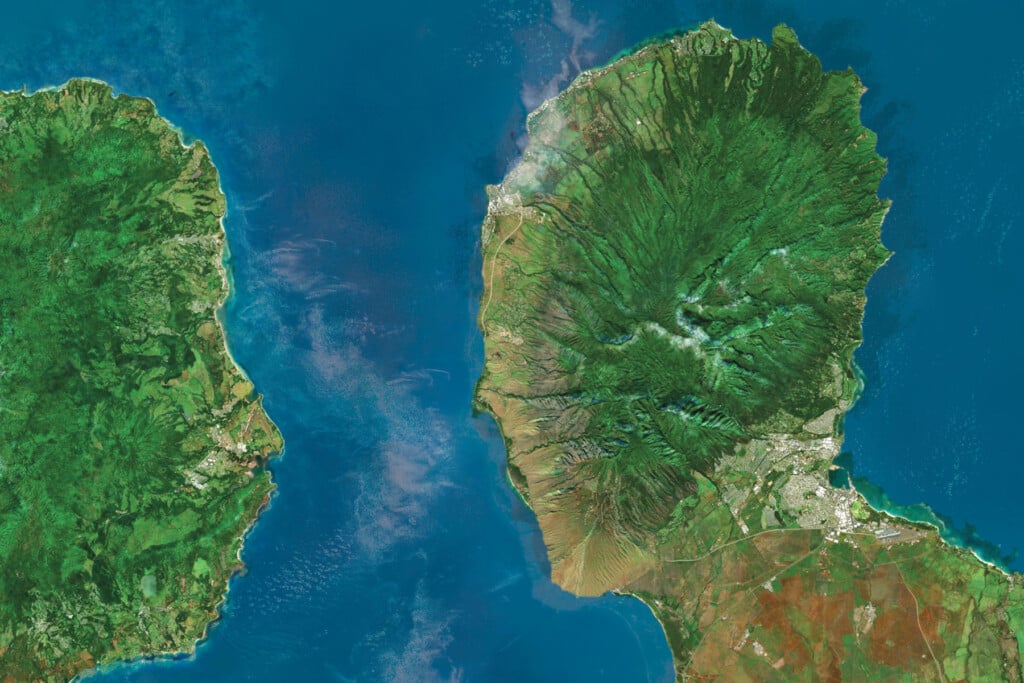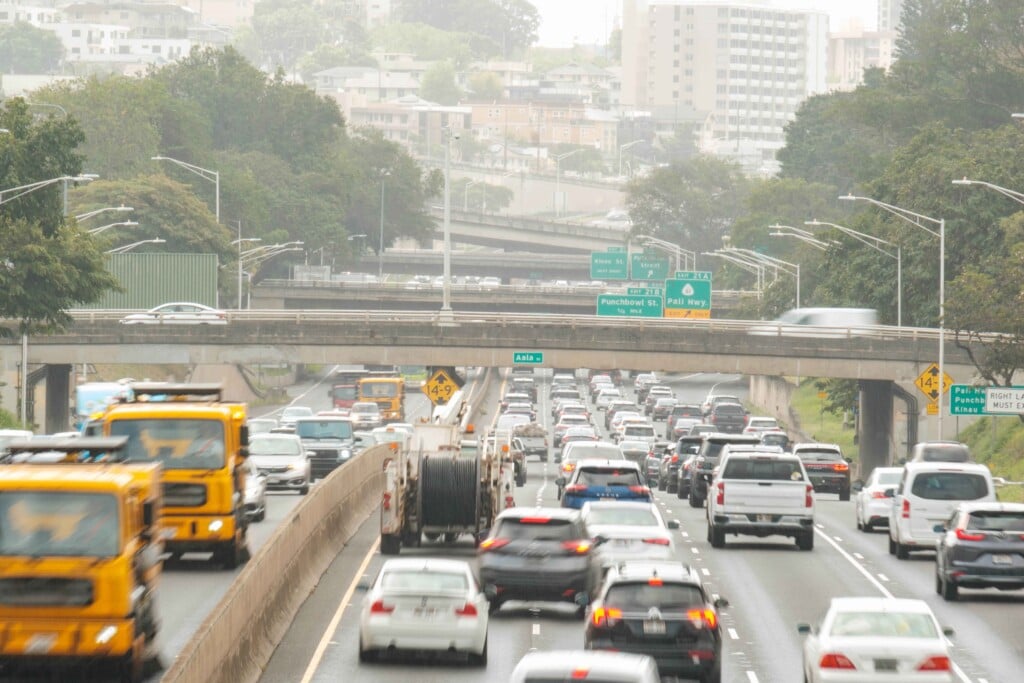New Wheels for TheBus
Some buses have passed the million-mile mark. Now the fleet is getting an overhaul, including new EV and clean-diesel models.

Photo: Aaron Yoshino
Honolulu’s new electric buses still wear their iconic yellow and orange on the outside, but inside they have quieter engines and smoother rides.
“The operators love them because they’re really powerful and really quiet,” says Jon Nouchi, deputy director of Honolulu’s Department of Transportation Services. People can talk and “not be overcome by the noise and vibration.”
The city’s older buses – many still operating beyond their mileage “life expectancy” – are being phased out to make room for new buses – some of them built to meet the fleet’s zero-emissions goal by 2035.

Some of the new 40-foot, low-floor buses feature vinyl seating (right), which is easier to
clean than fabric seats on the older high-floor buses (left). | Photo: Aaron Yoshino
But not every new bus is electric. Oahu Transit Services, a nonprofit that operates TheBus and HandiVan for the City and County of Honolulu, is also getting 35 new 60-foot, articulated, fuel-efficient and “clean-diesel” buses over a three year period from Nova Bus, a North American manufacturer, under a deal signed in August. Clean diesel refers to a diesel fuel that is refined to improve combustion efficiency and reduce harmful emissions.
Nouchi says the 60-foot articulated buses will be among the last the city electrifies because of current technology: the heavy weight of their batteries and the limited range of those batteries.
The articulated buses, which can seat 54 people, operate on some of O‘ahu’s busiest routes. However, some roads and highways exclude their use: For example, 40-foot buses ply the Mākaha to Ala Moana Center’s Route C instead of the heavier 60-foot ones because of the weight limit on a bridge near Mākaha Beach Park, according to Nouchi.
“We don’t necessarily want to be carrying thousands and thousands of pounds of batteries onboard these already heavy, articulated 60-foot buses,” he says. “The impact to the roadways would be pretty terrible, and the cost would actually be quite extravagant.” DTS plans to stop buying diesel buses after fiscal year 2025.
Hawaii Business got an exclusive tour inside of the Kalihi Bus Facility’s maintenance department, where buses are constantly being repaired, fixed and upgraded.
Some Cost More Than $1 Million
OTS also acquired 30 new 60-foot articulated buses prior to the latest Nova Bus deal. These fuel-efficient diesel buses went into service last year.
Some of the new 60-foot buses, made by New Flyer Industries, feature vinyl seating, woodlike floors, beach designs by the doors, and cameras that feed a security monitor next to the driver’s seat.
Every bus has custom-built seating arrangements, interior colors, windows and bike racks, based on city requests. The vinyl seats on the new buses are easier to clean than the fabric ones on older buses – a nod to the pandemic and passenger sensibilities, Nouchi says.
A 60-foot heavy duty, clean diesel articulated bus costs about $1.1 million, according to DTS. A 40-foot diesel bus costs $600,000, but a diesel/hybrid is an additional $100,000; 40-foot electric buses can cost over $1 million.
Nouchi says the federal government covers 80% of the cost of a new bus, and the city pays 20%. The OTS fleet has about 466 buses, including 17 electric buses now in service, with 50 to 60 new buses ordered in a typical year.
Repurposing Old Busses
The minimum life of a city bus is 12 years or 500,000 miles, Nouchi says, though many run well past that – some operate for more than 20 years. “We run these buses about as hard as any agency in the country,” says Nouchi, noting a lot “have gone over the million-mile mark without a major overhaul.”
But it “gets harder and harder to find parts” as the buses get older, he says. Retired buses are salvaged for parts, though some buses that are still operational get donated to Neighbor Islands for county bus systems or are auctioned, Nouchi says. Hawai‘i County has received 13 buses from Honolulu for its Hele-On transit system.
Most Honolulu buses can stoop down when stopped so passengers can board more easily, but 15 “high-floor” buses built in 2003 are still running, according to Nouchi.
In 2015, there was a plan to repurpose old city buses into shelters and showers for the homeless. But the plan died because it was “cost prohibitive,” says Jun Yang, who helped spearhead the project. He is currently the homeless coordinator for the state Department of Transportation.
The challenges included where to park the buses, and how to provide water and dispose of wastewater.
“At the end of the day, it became pretty expensive to get one of these done to retrofit a bus,” says Yang.
Getting Ready for Rail
The city plans to open rail’s first 10 miles from East Kapolei to Aloha Stadium this summer or early fall and intends to increase bus service to rail stations. TheBus and HandiVan riders who pay fares with HOLO cards can use them on the rail as well.
Bus ridership continues to recover from the pandemic. As of December 2022, it was approximately 37% lower than pre-pandemic levels, according to OTS. But average weekday ridership was 116,795, up 15% from the previous year. As of February 2023, average weekday ridership was 127,640.
By the end of fiscal year 2024, DTS expects to have completed the procurement of another 19 electric buses, for a total of 36.
Currently, OTS has 25 electric vehicle dispensers and can charge 9 buses at a time, but Nouchi says they will eventually have to add charging infrastructure at its two main facilities and other transit centers across the island.
“Electrification is the greatest new, in-place and current thing on our horizon,” he says. “If we burn a gallon of diesel at a power plant and then plug our electric bus in and use the power from that same gallon of diesel — we get five times the mileage for that.
“The benefits are so far-reaching, that it’s hard for us to walk away from it.”
















